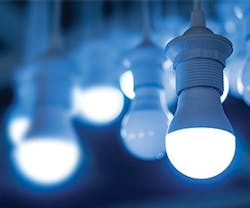While all artificial lighting exhibits some flicker, it varies widely by lamp type and model. Moreover, dimming capability, which helps to reduce energy consumption, may increase flicker. The performance of LED products in particular – largely as a result of the drivers’ functionality – has been reported in a wide range from good to poor.
Flickering lights can take a toll on occupants and their productivity. As a result, industry groups are developing criteria to better evaluate and rate flicker.
The Impact on Occupants and Productivity
The impact of flicker on occupants can be more than annoyance, eyestrain and complaints. A DOE study, Characterizing Photometric Flicker, reports neurological consequences, including headaches, migraines and photosensitive epilepsy. Reductions in visual-task performance have also been reported.
Sometimes flicker is only detected indirectly. If an object is moving across an occupant’s gaze, a stroboscopic effect can create hazards, especially in industrial settings. Indoor environments where occupants perform reading tasks or use video equipment may be prone to problems.
Some people who are sensitive to flicker may not recognize that it is the cause of discomfort or even consciously perceive it. Higher levels of ambient lighting and daylighting reduce the conscious perception of flicker.
Poor quality power from a utility can also cause lighting flicker. Some equipment in a building (laser printers, refrigerators, motors, etc.) may disrupt power harmonics. Lamps can even undermine themselves. BUILDINGS contributor Eric Woodroof found that a certain model of CFL caused flickering of LED lamps in one of his facilities. (See his article, “Flickering and Other LED Anomalies,” at BUILDINGS.com.)
Quantifying Performance
Flicker is garnering increasing attention from lighting designers and specifiers, the standards and specification community, and lighting manufacturers. An Institute of Electrical and Electronics Engineers group has developed a recommended practice for evaluating flicker risks, while ENERGY STAR and California’s Title 20 require reporting of flicker performance and/or are considering the adoption of flicker criteria.
To help specifiers measure the behavior of different lighting products, DOE evaluated the performance of three flicker meters. The results show that the commercial meters had similar measurement capabilities to each other and to a reference photoelectric characterization system. However, some differences were found when measurements were taken of light-intensity waveforms with significant high-frequency content greater than the dominant 120 Hz found at full output in many products. DOE also noted that incorrect configuration of the meters undermines accurate measurements.
